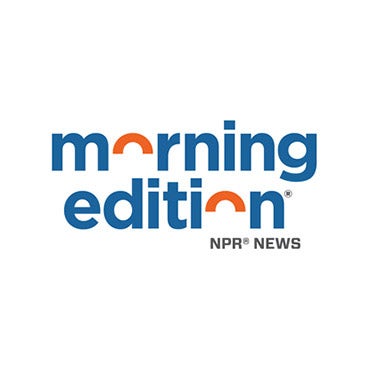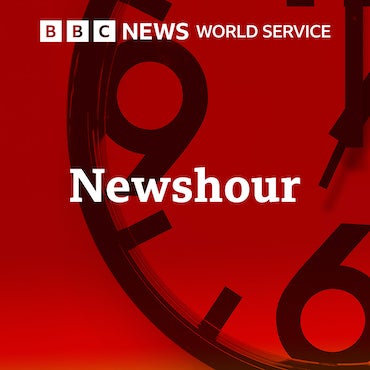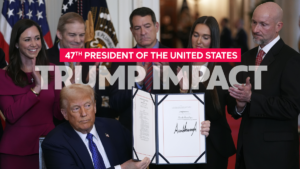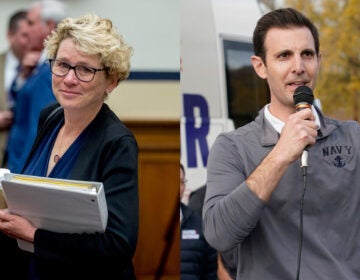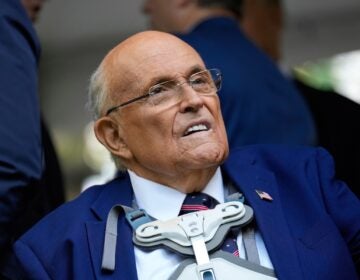Trump files late night executive order calling for an end to funding for NPR, PBS
The order cutting funding for NPR and PBS is “significant,” and puts smaller public media stations at greater risk.
Listen 1:07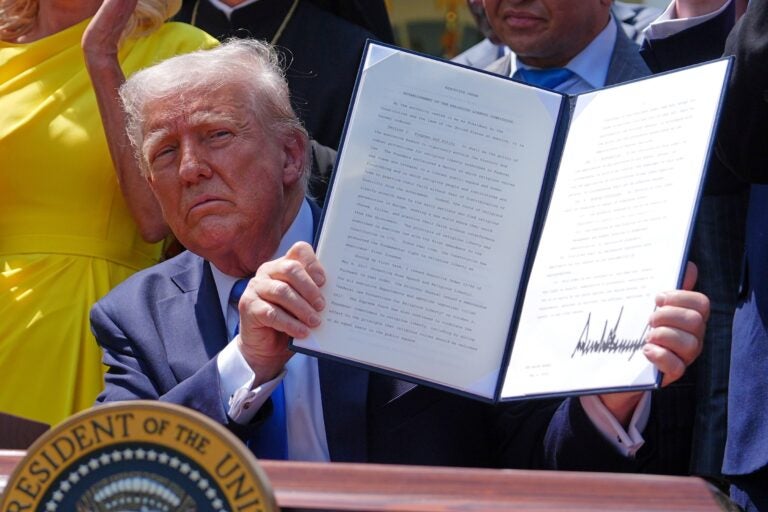
File - President Donald Trump holds up a signed executive order establishing the Religious Liberty Commission, during a National Day of Prayer event in the Rose Garden of the White House, Thursday, May 1, 2025, in Washington. (AP Photo/Evan Vucci)
From Philly and the Pa. suburbs to South Jersey and Delaware, what would you like WHYY News to cover? Let us know!
President Donald Trump issued an executive order late Thursday instructing the Corporation for Public Broadcasting to cease federal funding for NPR and PBS.
The president has regularly accused NPR and PBS of “leftist” and “woke” news coverage. In the latest executive order, titled “Ending Taxpayer Subsidization of Biased Media,” the White House wrote that, while the funding might have made sense when it started in 1967, “today the media landscape is filled with abundant, diverse, and innovative news options.”
“Government funding of news media in this environment is not only outdated and unnecessary but corrosive to the appearance of journalistic independence,” the order reads.
Reactions from public media leaders at both the national and local level came quick. Patricia Harrison, president and CEO of CPB, issued a statement that the president was overstepping.
“CPB is not a federal executive agency subject to the President’s authority,” she said. “Congress directly authorized and funded CPB to be a private nonprofit corporation wholly independent of the federal government.”
Harrison noted that federal public broadcasting law prohibits the president from such interference. Similar arguments compelled a federal judge to put a temporary halt to the president’s attempts to dismantle the Voice of America, a wholly government-funded broadcaster.
NPR President and CEO Katherine Maher said in a statement that the executive order is “an affront to the First Amendment rights of NPR and locally owned and operated stations throughout America to produce and air programming that meets the needs of their communities.
Maher added that, while “significant financial support comes from listeners, underwriters, and philanthropic grants,” federal funding remains “an essential aspect of public media.”
Less than 1% of NPR’s budget comes from federal funding, with a greater share of overall federal dollars going directly to local affiliates, such as WHYY, that have multiple other income streams through membership contributions, donations and grants. The executive order does not call for the elimination of CPB or the funding for local affiliates, such as WHYY, though the president is expected to request Congress for both in the near future.
Around 16% of PBS’s budget comes from federal funding, with more going to local affiliates. Many stations, such as WHYY, operate both NPR-affiliated radio stations and PBS-affiliated TV stations. Just over 7% of WHYY’s operating budget is derived from the CPB, with the rest coming from other sources. Local affiliates often fundraise partly off national content for contributions that fund local news and other programming.
In her statement, Maher said that, as a result, “every $1 of federal funding generates $7 from local sources, enabling stations to produce local journalism, support local and regional music and arts, and develop creative, informative and entertaining programming for distribution across the nation.”
CPB supports more than 4,400 reporters across 1,216 public radio stations and 365 public TV stations around the country, including more than 50 journalists at WHYY News department who report on the Delaware Valley region.
The president has called NPR and PBS news programming “biased.”
Dan Flynn, of Ambler, says that he agrees with Trump’s assertion. The retired entrepreneur, who contributes to WHYY monthly, said that he reads Billy Penn and often enjoys entertainment programming from PBS aired on WHYY-TV, but he believes most news outlets are biased in some ways.
“I would prefer that any funding was kept out of what I consider politics and news reporting,” he said. “I don’t see it as ever being able to be not biased toward particular viewpoints.”
NPR and PBS have often been cited as among the most trustworthy news organizations, including by Pew Research Center.
However, Flynn pointed to Maher’s appearance at the congressional subcommittee hearing, in which Republican members criticized her for prior statements about Trump and other comments before she became CEO of NPR.
“They had the facts,” Flynn said. “Not that we can’t all have opinions about things, but the country is divided.”
At the same hearing, Maher said that there is a strict firewall between the CEO and the NPR newsroom.
“In other words, I do not direct coverage, I do not influence stories, I have no control over editorial decisions, and I have no say in how NPR’s journalists will cover today’s hearing,” she told the committee. “This firewall safeguards against any real or perceived conflict of interest or undue influence, to protect the integrity and independence of NPR’s reporting.”
When informed that WHYY and other affiliates boast a similar structure, Flynn remained unconvinced.
“The difference between MSNBC and Fox is night and day, and I don’t see WHYY coming in the center,” he said.
Graduate Hospital resident Erich Klothen, who works in real estate, disagrees.
“I listen to WHYY for several reasons, but chief among them because I think they have trustworthy journalists offering nuanced coverage of issues at the local and national levels,” he said.
Klothen, who also regularly contributes to WHYY, said he believes the government has a role in ensuring people have access to the kind of information WHYY, NPR and PBS provide.
“It’s in the public interest to have news media be widely available,” he said. “As Thomas Jefferson said, ‘A well-informed citizenry is the best defense against tyranny.’”
Meanwhile, the public broadcasting world is waiting for Trump’s promised request to Congress to rescind all of CPB’s funding, including the 70% that goes to local stations.
WHYY CEO Bill Marrazzo said in a statement that, while such cuts would be “significant,” he expects the station to adapt to the circumstances and does “not anticipate a reduction in coverage.”
“Thanks to the support of our audience, WHYY is on solid financial footing,” he said. “But without federal funding, the road ahead becomes more challenging—not just in sustaining what we do now, but in continuing to grow and innovate. The loss would be felt nationwide. That said, many stations—especially those in rural areas—rely heavily on this funding to deliver trusted news, educational programming, and cultural content, and remain at far greater risk.”
One of those stations is WQLN, which serves the city of Erie and mostly rural Erie County. The NPR member station relies on federal funding for around 40% of its budget.
Cindy Spizarny, station president and CEO of WQLN, which also operates NPR and PBS affiliates, says that losing it would present an existential dilemma.
“I think it’s such an important asset to our community as all the other public media stations across the country are to their individual communities,” she said in a prior interview. “It breaks my heart to think that there’s a chance that there is a world where WQLN doesn’t exist.”
Financially situated between WHYY and WQLN is Lehigh Valley Public Media, where CPB funding makes up about 20% of the budget. LVPM also boasts NPR and PBS stations and provides hyperlocal news through lehighvalleynews.com.
LVPM Interim CEO Laks Srinivasan expressed confidence the public media organization will go on.
“We’re not going anywhere,” he said. “This will impact the things we’re doing. But we want the community to know we will continue to deliver news and content. This only increases our commitment to be local and continue to serve as we have.”
Many public broadcasters also serve as the Local Primary 1 station for their respective emergency alert system operational area — such as Philadelphia for WHYY — acting as the region’s primary broadcaster for receiving and relaying emergency alerts to other stations and cable systems.
“That ensures the public receives timely and potentially lifesaving information,” Marrazzo said.
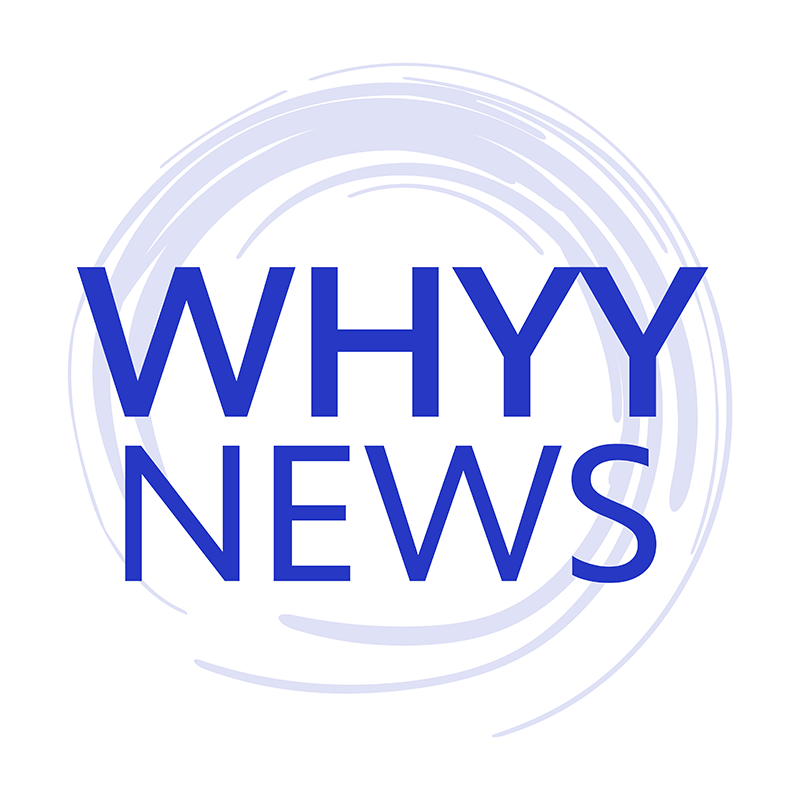
Get daily updates from WHYY News!
WHYY is your source for fact-based, in-depth journalism and information. As a nonprofit organization, we rely on financial support from readers like you. Please give today.
